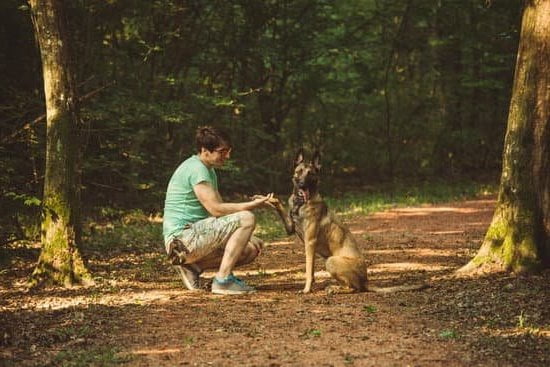Training a dog to be off leash is not only incredibly rewarding but also vital for the safety and freedom of both the dog and its owner. The bond that is formed through off-leash training allows for a deeper sense of trust and understanding between the two, fostering a lifelong relationship filled with joy and adventure.
One of the primary benefits of training a dog to be off leash is the freedom it provides. Dogs have an innate desire to explore their surroundings, and being confined to a leash can limit their natural instincts. Off-leash training allows dogs to run, play, and investigate their environment with ease, giving them much-needed mental stimulation and physical exercise.
Moreover, off-leash training enhances the bond between dogs and their owners. By teaching our furry friends to follow commands without being tethered, we create a stronger sense of trust and reliance. This newfound trust empowers both parties, as owners can feel confident in their dog’s ability to listen and respond, while dogs gain confidence in their independence while still maintaining a connection with their human companion.
In this article on how to train a dog no leash, we will delve into the importance and benefits of off-leash training. We will explore the basics of dog training techniques that emphasize positive reinforcement and consistency. Additionally, we will provide step-by-step instructions on essential commands like recall, sit, stay, and down – all crucial for effective off-leash control and safety.
Through this comprehensive guide, you will learn proven techniques to establish trust and effective communication with your dog using body language signals. We will also cover transitioning from long leash training to full off-leash capabilities in various scenarios. It is our aim to equip you with the necessary knowledge to overcome distractions and navigate challenges during your journey towards advanced off-leash skills.
By implementing the tips provided in this article and dedicating time to consistent practice and reinforcement, you can unlock a world of freedom for your canine companion while strengthening the bond that exists between you. Get ready to embark on an exciting adventure of off-leash training with your furry friend.
Understanding the Basics of Dog Training
When it comes to training a dog to be off leash, understanding the basics of dog training is essential. Positive reinforcement and rewards are key factors in successful training. By rewarding good behavior, dogs learn what is expected of them and are motivated to continue exhibiting those behaviors. Consistency and patience also play vital roles in successful training.
Positive reinforcement involves rewarding desired behaviors with treats, praise, or other forms of rewards that are appealing to the dog. This creates a positive association with the desired behavior and encourages the dog to repeat it. It is important to reward immediately after the desired behavior occurs so that the dog can make a clear connection between the behavior and the reward.
Consistency is crucial when training a dog. Dogs thrive on routine and predictability, so it is important to set clear expectations and reinforce them consistently. Using consistent commands and cues will help your dog understand what you want from them. It is also important for all members of the household to be consistent with training methods and expectations.
Patience is another important aspect of dog training, especially when teaching a dog to be off leash. Each dog learns at their own pace, so it is important to remain patient throughout the process. Rushing or becoming frustrated can impede progress and may cause confusion for your dog.
By understanding these basics of dog training – positive reinforcement, consistency, and patience – you will lay a strong foundation for all aspects of off-leash training. With these principles in mind, you can effectively train your dog to respond reliably even without a leash.
| Training Basics | Description |
|---|---|
| Positive Reinforcement | Rewarding desired behaviors with treats, praise or other rewards |
| Consistency | Setting clear expectations and reinforcing them consistently |
| Patience | Allowing dogs to learn at their own pace and remaining patient throughout the process |
Building a Strong Foundation
Basic obedience training is essential when teaching a dog to be off leash. It forms the foundation for a dog’s understanding of commands and builds their confidence in responding to those commands reliably. Two crucial aspects of basic obedience training that contribute to off-leash reliability are recall training and teaching the sit, stay, and down commands.
Recall training is one of the most important skills for off-leash dogs. It ensures that your dog will come back to you promptly when called, even without a leash. To train recall effectively, start in a low-distraction environment such as your home or backyard.
Use positive reinforcement techniques such as treats, praise, and toys to reward your dog for coming back to you when called. Gradually increase the level of distractions while reinforcing the recall command consistently and generously rewarding success.
Sit, stay, and down commands are also crucial for off-leash control and safety. Teaching these commands helps maintain control over your dog’s movements in various situations. Begin by teaching each command separately using positive reinforcement techniques. Start with short durations and gradually increase the length of time your dog must hold each position before being released. Practice in different locations, gradually introducing distractions to ensure reliable response regardless of the environment.
| Command | Description |
|---|---|
| Recall | Teaches the dog to come when called without a leash |
| Sit | Teaches the dog to sit on command |
| Stay | Teaches the dog to remain in a designated position until released |
| Down | Teaches the dog to lie down on command |
Establishing a strong foundation through basic obedience training sets the stage for successful off-leash training. It creates a clear line of communication between you and your dog and builds trust, respect, and reliability.
By consistently practicing these fundamental commands, you can ensure that your dog understands and responds to your cues even without the constraint of a leash. With a solid foundation of basic obedience skills, you can move on to more advanced off-leash training techniques and enjoy a deeper bond with your four-legged companion.
Establishing Trust and Communication
Building a strong bond and trust between the dog and owner is essential for successful off-leash training. This section will explore the importance of establishing trust and effective communication techniques to enhance the training experience.
Importance of Bond and Trust
Developing a strong bond with your dog is crucial in off-leash training. When a dog trusts its owner, it becomes more willing to follow commands and respond reliably, even without a leash. The foundation of trust is built through consistent positive reinforcement, patience, and understanding.
To establish this bond, spend quality time with your dog, engage in interactive play sessions, go for regular walks or hikes together, and provide mental stimulation through obedience exercises. Building a strong bond based on love, care, and respect will make your dog more receptive to your commands during off-leash training.
Effective Communication Techniques
Communication plays a vital role in off-leash training as verbal commands may not always be sufficient or effective. Dogs predominantly communicate through body language, so learning to understand their signals and responding appropriately can strengthen the bond between you and your furry friend.
One effective technique is using hand signals along with verbal cues. Dogs are highly visual creatures and often pick up on hand gestures quicker than vocal instructions alone. Consistently pairing specific hand signals with commands such as sit or stay will help your dog understand what you expect from them.
Another important aspect of communication is consistency. Use consistent body language, tone of voice, and signals every time you give a command. Dogs thrive on routine and consistency brings clarity to their understanding of what behavior is expected from them.
It’s also important to pay attention to your own body language during training sessions. Stay calm, relaxed, confident, and maintain an assertive yet gentle posture. Avoid any aggression or forceful handling as it can erode trust and hinder progress in off-leash training.
By establishing trust and using effective communication techniques, you can build a strong foundation for successful off-leash training with your dog. The next section will explore the concept of long leash training and how it aids in the gradual transition to off-leash training.
Utilizing Long Leash Training for Gradual Transition
Long leash training is a crucial step in the gradual transition to training a dog to be off leash. This method allows for controlled freedom while still maintaining a level of control and safety. By utilizing a long leash, owners can provide their dogs with more space to explore and roam, while still maintaining the ability to influence their behavior and ensure their safety.
Understanding the concept of long leash training
Long leash training involves using a leash that is longer than the traditional 6-foot range. A common length for a long leash is around 15 to 30 feet, depending on the dog’s size and environment. The longer length allows for increased freedom of movement without sacrificing control.
During long leash training, it’s essential to make sure that the dog understands they are still connected to their owner through the leash. This can be accomplished by initially holding onto the handle or end of the leash so they feel your presence and support as they explore.
Step-by-step guide on using a long leash effectively
- Choose an appropriate location: Find an open space such as a park or field where you can safely practice long leash training without too many distractions or potential hazards.
- Attach the long leash: Securely attach one end of the long leash to your dog’s collar or harness.
- Give some slack: Let out enough slack in the leash so that your dog has room to move around comfortably.
- Practice recall exercises: Begin by practicing recall exercises, calling your dog back to you while still holding onto part of the long leash.
- Gradually increase distance: As your dog becomes more comfortable and responsive during recall exercises, gradually let go of more of the long leash, allowing them more freedom while still maintaining control.
- Reinforce good behavior: Use rewards and positive reinforcement techniques when your dog responds correctly to recall commands or other cues while on a long leash.
- Gradually decrease reliance on the leash: Over time, continue to decrease your reliance on the long leash by using less of it or even switching to a regular leash intermittently.
By following these steps, dog owners can help their furry companions become accustomed to more freedom and gain confidence while still being under their control. It is important to remember that each dog is different, so the progression from long leash training to off-leash training will vary. Patience and consistency are key when working towards successful off-leash training.
Practicing in a Controlled Environment
Off-leash training in a controlled environment, such as fenced areas or controlled spaces, is an essential step in the process of training a dog to be off leash. This section will discuss the benefits of practicing off-leash training in a controlled environment and provide tips for selecting appropriate locations and ensuring safety during training sessions.
Practicing off-leash training in a controlled environment offers several advantages. Firstly, it provides a safe and secure space where both the dog and the owner can focus solely on training without worrying about potential hazards or distractions. A fenced area allows for freedom of movement while minimizing the risks associated with training in open spaces.
When choosing a location for off-leash training, it is important to consider factors such as size, layout, and accessibility. Ensure that the area is adequately enclosed so that your dog cannot escape or be at risk of encountering dangerous situations. Additionally, select an environment that suits your dog’s individual needs – whether it’s an open field for running or a more structured space with various obstacles for agility training.
During off-leash training sessions, always prioritize safety. It is crucial to have complete control over your dog’s behavior and ensure they respond promptly to commands even when distractions are present. Gradually introduce levels of difficulty by gradually increasing distractions within the controlled environment. This could include using toys or treats as distractions or incorporating other dogs into the training sessions.
Remember to observe your dog’s body language and be attentive to any signs of stress or discomfort during off-leash training sessions. Monitoring their behavior can help you identify any potential issues early on and address them appropriately.
Overcoming Challenges
Training a dog to be off leash comes with its own set of challenges, particularly when it comes to navigating distractions and reinforcing recall. Dogs are naturally curious and easily distracted by their surroundings, making it essential for owners to establish a strong foundation of training and reinforce recall commands consistently. This section will explore common challenges that arise during off-leash training sessions and provide strategies for overcoming them.
1. Addressing Common Distractions: When training a dog off leash, distractions are bound to occur. Whether it’s other animals, unfamiliar scents, or interesting objects, these distractions can easily divert your dog’s attention away from you. To overcome this challenge, use positive reinforcement techniques to redirect your dog’s focus back to you. Rewarding them with treats or praise when they respond appropriately to your command will help reinforce their ability to ignore distractions.
2. Reinforcing Recall Commands: One of the most crucial skills in off-leash training is recalling your dog reliably. However, as dogs become more comfortable exploring their surroundings without a leash, they may be tempted to ignore the recall command. To reinforce recall effectively:
- Consistency: Use a consistent recall command such as “come” or “here” every time you want your dog to return to you.
- Rewards: Provide high-value rewards such as treats or favorite toys when your dog responds promptly to the recall command.
- Vary Environments: Practice recall commands in different environments to ensure that your dog understands the command regardless of the setting.
By implementing these strategies consistently, you can strengthen your dog’s understanding of the recall command and increase their reliability when off leash.
3. Managing Unexpected Stimuli: During off-leash training, unexpected stimuli such as loud noises or sudden movements can startle your dog and cause them to lose focus. It is crucial to desensitize your dog to these stimuli gradually. Start by exposing them to mild distractions and gradually increase the intensity as they become more comfortable. Additionally, teaching your dog the “leave it” command can help redirect their attention away from potentially dangerous stimuli.
Successfully navigating distractions and reinforcing recall commands are vital steps in training a dog to be off leash. With consistent practice and patience, you can overcome these challenges and ensure that your dog remains safe and under control in various environments.
Advanced Off-Leash Skills
In the quest to train a dog to be off leash, there comes a point where basic obedience commands are no longer enough. This is when advanced off-leash skills come into play, taking training to the next level. Developing advanced off-leash skills allows for even greater control and safety in various environments, such as parks, beaches, or public areas.
One of the key aspects of advanced off-leash training is establishing off-leash reliability in different environments. Dogs should be able to respond to commands consistently regardless of distractions or unfamiliar settings. This requires gradually exposing the dog to new environments and gradually increasing the difficulty level of training exercises. By practicing in different locations and introducing distractions, owners can ensure that their dogs will maintain proper behavior and responsiveness even in challenging situations.
Along with location-specific reliability, it is important to introduce advanced off-leash commands that enhance control and safety during training sessions. Commands like “leave it” and “heel” provide additional tools for guiding a dog’s behavior while off leash. “Leave it” teaches a dog not to approach or grab something potentially harmful, while “heel” helps maintain close proximity and prevents running away or wandering too far.
It is crucial for dog owners to understand that achieving advanced off-leash skills takes time, patience, and consistency. Training should always be conducted with positive reinforcement techniques, rewarding desired behaviors and ignoring or redirecting unwanted behaviors. Additionally, maintaining trust and clear communication between the owner and dog through body language and hand signals remains essential in this phase of training.
With dedication and persistence, owners can reach a point where their dogs have reliable off-leash skills, allowing for an even stronger bond based on trust, clear communication, and freedom. The rewards of mastering advanced off-leash training are immeasurable – the ability to enjoy outdoor activities without constraints while ensuring the safety of both the dog and those around them.
Safety Precautions and Legal Considerations for Off-Leash Dogs
Off-leash training can provide numerous benefits for both dogs and owners. However, it is crucial to prioritize the safety of your dog and comply with local laws and regulations. This section will discuss the importance of safety precautions and legal considerations when training a dog to be off leash.
Firstly, it is essential to understand the laws and regulations in your area regarding off-leash dogs. Many jurisdictions have specific rules about where dogs can be off leash, such as designated dog parks or certain hours of the day. Familiarize yourself with these regulations to avoid any potential legal issues or fines.
In addition to following the law, there are several safety precautions you should take when training your dog to be off leash. One important aspect is ensuring that your dog has proper identification. Make sure they are wearing a collar with identification tags that include your contact information. It’s also recommended to have your dog microchipped as an added layer of identification.
Another key safety precaution is choosing appropriate training locations. Start practicing off-leash training in enclosed areas, such as fully fenced yards or secure, designated dog parks. This way, you minimize the risk of your dog running off or encountering dangerous situations.
When starting off-leash training in public spaces, always keep an eye on your surroundings and potential hazards. Be aware of traffic, bodies of water if your dog loves swimming, other animals that may provoke a reaction from your dog, or any potentially toxic substances they might ingest.
Lastly, ensure that your dog has strong recall skills before fully embracing off-leash activities in non-enclosed areas. Reinforce recall commands consistently during training sessions and gradually increase distractions to test their reliability. Remember that maintaining control over your dog is crucial for their safety and the safety of others.
By prioritizing safety precautions and adhering to local laws and regulations, you can enjoy a fulfilling off-leash relationship while keeping your pet safe and secure.
Conclusion
In conclusion, training a dog to be off leash offers numerous benefits for both the dog and the owner. The freedom and independence it provides allows the dog to explore and enjoy their surroundings while also promoting a stronger bond with their owner. Through positive reinforcement, consistency, and patience, basic obedience training can establish a foundation for off-leash control and safety.
Building trust and effective communication between the dog and owner is crucial in off-leash training. By understanding body language and utilizing hand signals, the owner can establish clear communication with their dog. Additionally, incorporating long leash training can aid in gradually transitioning from on-leash to off-leash control.
Practicing in controlled environments such as fenced areas or controlled spaces can help build confidence in both the dog and the owner during off-leash training sessions. Overcoming challenges like distractions or reinforcing recall is essential for maintaining focus amidst various stimuli. As skills progress, advanced off-leash commands can further enhance control and safety in different environments.
It is important to consider safety precautions and legal regulations when engaging in off-leash activities with your dog. Understanding local laws and ensuring the well-being of your dog and others should always be a top priority.
Frequently Asked Questions
How do you train a dog without a leash?
Training a dog to be obedient without a leash requires a combination of consistency, positive reinforcement, and patience. Start by teaching your dog basic commands such as “sit,” “stay,” and “come” in an enclosed area or backyard where they can’t easily run off.
Use treats or rewards to reinforce good behavior and gradually increase the distractions to improve their focus and response. Continuously practice these commands in various environments, making sure to gradually transition from on-leash training to off-leash training in safe and secure spaces.
Can my dog be without a leash?
Whether or not your dog can be without a leash depends on several factors including their temperament, training level, and the specific circumstances you find yourself in. While some dogs naturally have better recall abilities than others, it’s important to remember that even well-trained dogs can become distracted or tempted by their surroundings.
For this reason, letting your dog roam off-leash should be done responsibly in controlled environments like designated off-leash areas or securely fenced-in spaces. Additionally, it is crucial to ensure that your dog is legally allowed off-leash according to local regulations.
Can you train your dog to walk beside you without a leash?
Training a dog to walk calmly beside you without a leash is possible but requires consistent training and reinforcement over time. Begin by teaching your dog loose leash walking techniques while on a leash using positive reinforcement methods. Encourage them to stay close by rewarding them for staying at your side and providing treats intermittently throughout the walk for good behavior.
As they become more comfortable with walking on a leash, start practicing the same behaviors without one in secure areas like fenced backyards before venturing into more public spaces. It’s essential to remember that while off-leash walking may be achievable for some dogs, maintaining safety should always be the top priority by ensuring proper obedience training and following any local laws pertaining to walking dogs off-leash.

Welcome to the blog! I am a professional dog trainer and have been working with dogs for many years. In this blog, I will be discussing various topics related to dog training, including tips, tricks, and advice. I hope you find this information helpful and informative. Thanks for reading!





